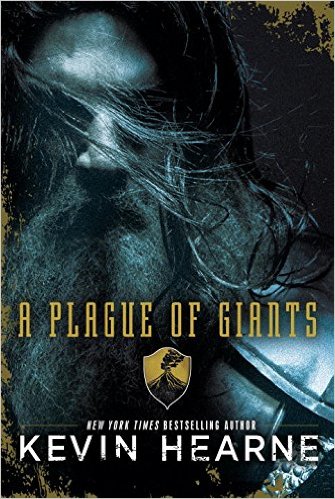 A Plague of Giants by Kevin Hearne
A Plague of Giants by Kevin Hearne Formats available: hardcover, paperback, ebook, audiobook
Series: Seven Kennings #1
Pages: 618
Published by Del Rey Books on October 17th 2017
Purchasing Info: Author's Website, Publisher's Website, Amazon, Barnes & Noble, Kobo, Bookshop.org
Goodreads
In the start of a compelling new series, the New York Times bestselling author of The Iron Druid Chronicles creates an unforgettable fantasy world of warring giants and elemental magic.
In the city of Pelemyn, Fintan the bard takes to the stage to tell what really happened the night the giants came . . .
From the east came the Bone Giants, from the south, the fire-wielding Hathrim - an invasion that sparked war across the six nations of Teldwen. The kingdom's only hope is the discovery of a new form of magic that calls the world's wondrous beasts to fight by the side of humankind.
My Review:
This is a book to savor. It’s very long and incredibly involved and left me with a marvelously horrible book hangover. And I loved every minute of it.
There’s no singular hero in A Plague of Giants, although there are plenty of people who do heroic things. But there’s no Frodo or Aragorn or Harry to lead the charge.
Instead, we have Fintan the bard, who may have participated in a few bits of the story, but who is not the hero. Fintan is the one telling the tale, using all of the powers at his command as a master of the bardic arts. But it is not his story that he tells. Instead, it is the story of every person in Teldwen whose life has been uprooted, or ended, by the invasion of not one but two armies of giants bent on conquest.
Even one army of giants is not enough to make this big of a mess of a the world.
At least one set of giants is known. And their motives are understandable, even if their methods are often brutal. The Hathrim are masters of fire, but even their cities can be overwhelmed when a dormant volcano wakes up. But they are masters enough of their element that they could see it coming in time to evacuate. Their plan is to use the tragedy as an opportunity to carve out new, resource-rich lands on the mainland.
But they lands they choose, while currently unoccupied, are not unowned. And border on the lands of their natural enemies. If the Hathrim are masters of fire, the Fornish are masters of woodcraft and forest lore. The trees that the Hathrim view as mere fuel for their fires, the Fornish see as sacred.
The Hathrim fire mastery and the Fornish command of all that grows in the land are merely two of the seven kennings of the series title. Three of the other kennings are the standard ones of so much fantasy and mythology; air, water and earth. Just as the Hathrim are fire masters, the Raelech are masters of the earth, the Brynts are water masters, and the Nentians have the mastery of the air.
But in the face of the invasion from both the known and feared Hathrim and the unknown and even more fearsome “Bone Giants” the sixth kenning finally appears. Just as the Fornish have power over all plants that grow, the first speakers of this new, sixth kenning have control over all animal life, from the smallest insect to the largest beast.
And the Bone Giants have invaded in search of the elusive seventh kenning, which no one has ever seen, heard of, or even speculated about. But whatever it may be, the Bone Giants are laying waste to vast swaths of Teldwen in order to locate it. Whatever and wherever it might be.
The story that Fintan the bard tells is the story of every person of every nation who becomes instrumental in the fight against both sets of terrible giants – and the story of the giants as well.
A Plague of Giants is an epic tale told by a master storyteller. And it is far from over.
Escape Rating A+: I absolutely loved A Plague of Giants. Which makes it very hard to write a review. Unless I just squee. A lot.
This both is and isn’t like a typical epic fantasy book. Yes, it’s long and has a huge cast of characters, so that part is very like. But it’s different in a couple of key aspects.
First, instead of being a narrative quasi-history, this is the story itself being told by its partipants, through the means of the bard’s magic. We’re not reading a history or quasi-history, instead Fintan is reciting events for his crowd of listeners in the words and images of the principal participant. It feels different.
The author Kevin Hearne said that he was trying to recreate the feeling of the old bardic tales as Homer used to tell them. I can’t say whether he succeeded, but he certainly has created something different. And compelling.
There’s something about the way that Fintan tells the story that reminds me of Kvothe in The Name of the Wind. I’m not sure why, but it just does.
Another difference in A Plague of Giants is that there are no clear heroes, and not really any clear villains, either. Not that one of the characters isn’t villainous, but he’s far from being a mover and shaker on either side.
We are able to see the story from the Hathrim point of view and it’s obvious that from their own perspective they are not evil. They think they are doing right by their own people, and don’t particularly care who they have to lie to or mow down to accomplish their goals. But it feels like real-politik, not evil.
Even the Bone Giants don’t think they are evil. Not that they don’t commit plenty of seemingly evil actions. But we don’t yet know enough to know what motivates them. So far, at least, it is not evil for evil’s sake. It looks like religious fanaticism, but even that isn’t certain. And we know that they think they have been provoked. (And there is something about their unknown nature and implacability that reminds me a bit of Jim Butcher’s Codex Alera. But I’m not certain of the why of that reminder either, just that it feels right.)
Fintan is not the hero, and does not intend to be. It’s his job to tell the story – not to fix it. Whether anyone else will emerge as the hero is anyone’s guess at this point.
Each of the individuals that Fintan portrays does an excellent job of both representing their people and illustrating their own portion of what has become a world-spanning story. Some of them stand out more than others. Some of them survive, where others do not. But their heroic acts are confined to their small piece of the puzzle.
At the same time, the flow from one character to another, and from one day to another of Fintan’s telling of the tale, is surprisingly compelling. With the end of each tale, the reader (or at least this reader) is incapable of resisting the compulsion to find out just a bit more.
I still feel compelled. The second book in the series will be titled A Blight of Blackwings, when it is published at some future unspecified date. And I want it now. Impatiently. Passionately. Desperately.

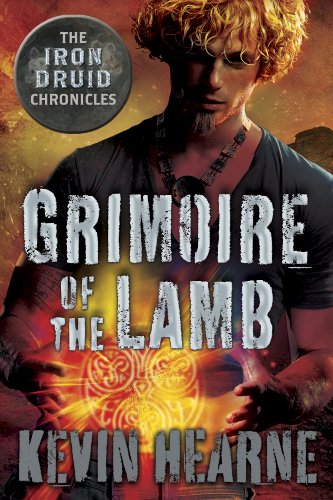 The Grimoire of the Lamb (The Iron Druid Chronicles, #0.4) by
The Grimoire of the Lamb (The Iron Druid Chronicles, #0.4) by 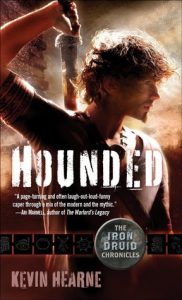 Grimoire of the Lamb is a prequel story to the
Grimoire of the Lamb is a prequel story to the 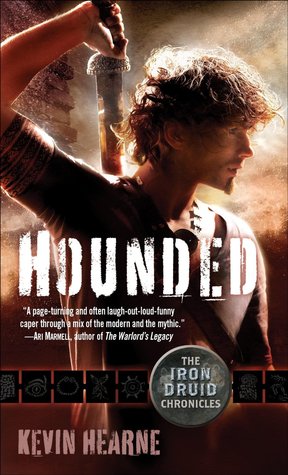 Hounded (The Iron Druid Chronicles, #1) by
Hounded (The Iron Druid Chronicles, #1) by 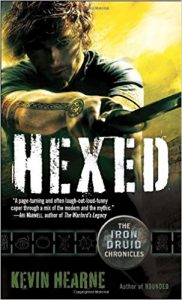 Hexed is up next. Atticus doesn’t trust witches. And there’s a good reason. Again. Fantastic!
Hexed is up next. Atticus doesn’t trust witches. And there’s a good reason. Again. Fantastic!